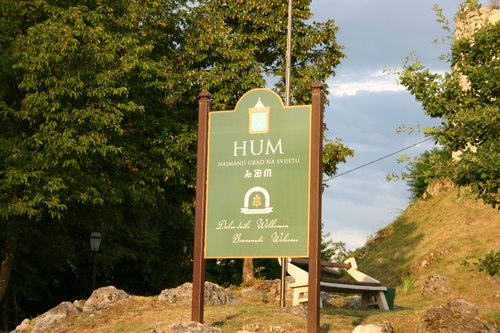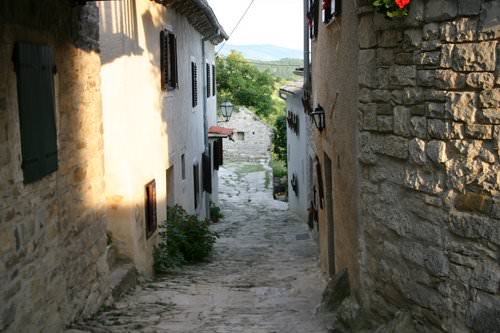With its Italian flavour and the sparkling sea, Croatia’s Istrian Coast is a tourist magnet. The true magic of Istria , however, lies inland. Tucked between ripening vineyards and olive farms, you’ll find dainty hilltop towns in a rainbow of pastel shades. One of my favourite stops along this route is the quirky microscopic  town of Hum.
town of Hum.
Hum holds the unique distinction of being the world’s smallest town, a fact that draws tourists away from the pebbled beaches and up to the town’s sturdy eleventh century iron gates. Hum is probably smaller than most villages around the world –the town tour can be completed in as little as ten minutes– and yet its medieval charm doesn’t fail the continuous trickle of dusty backpacks that work their way up here.
The town itself has a period drama movie-set feel to it. Walking around Hum, you keep expecting a loud call of “Action!” and for the extras to flood the deserted lanes. Instead, you’ll spot abandoned footballs, drying laundry and maybe the occasional resident –stealing a look from behind floral kitchen curtains, selling souvenirs, mostly bottles of homemade olive oil and brandy, or simply passing you on their way out.
 The most eminent structure here is the 12th century St. Jerome Church. Sitting outside the fortification, near the cemetery, its walls boast of ancient engravings: frescos and verses in the lost Glagolitic script, making this a place of great historical and cultural significance in the region. The Glagolitic script is considered to be the earliest form of written Croatian and a precursor to present day Cyrillic. It was brought to the region by missionaries who wanted to translate the Bible and make it more accessible. Today the script is commemorated through the Glagolitic Alley, a trail of monuments that runs through several villages and ends at the Hum town gate.
The most eminent structure here is the 12th century St. Jerome Church. Sitting outside the fortification, near the cemetery, its walls boast of ancient engravings: frescos and verses in the lost Glagolitic script, making this a place of great historical and cultural significance in the region. The Glagolitic script is considered to be the earliest form of written Croatian and a precursor to present day Cyrillic. It was brought to the region by missionaries who wanted to translate the Bible and make it more accessible. Today the script is commemorated through the Glagolitic Alley, a trail of monuments that runs through several villages and ends at the Hum town gate.
 Inside the walls, the town’s twin streets run around and form a perfect loop. On either side are sturdy, stone homes; one of these doubles as the obligatory local museum, with a little arts, crafts and souvenir store attached to the side. Another towering church and the modest mayoral seat complete the tour. And once the sights have been covered, there is but one thing to do, head to the local restaurant, Humska Konoba. Like any eatery worth its salt in the region, this one too serves all things truffles. But its magic lies in the local schnapps it serves. This magical concoction is created from a two thousand year old secret recipe full of herbs and white mistletoe. While you won’t be able to squeeze out the recipe, you’ll get as many refills as you ask for and then one more!
Inside the walls, the town’s twin streets run around and form a perfect loop. On either side are sturdy, stone homes; one of these doubles as the obligatory local museum, with a little arts, crafts and souvenir store attached to the side. Another towering church and the modest mayoral seat complete the tour. And once the sights have been covered, there is but one thing to do, head to the local restaurant, Humska Konoba. Like any eatery worth its salt in the region, this one too serves all things truffles. But its magic lies in the local schnapps it serves. This magical concoction is created from a two thousand year old secret recipe full of herbs and white mistletoe. While you won’t be able to squeeze out the recipe, you’ll get as many refills as you ask for and then one more!
Written by Neha Puntembekar for EuropeUpClose.com

Ana-Maria
Thursday 19th of March 2015
I accidentally came across this article and basically I like it. It is very well written and nicely describes Hum, except in one detail which is, unfortunately, a huge mistake. The author stated: "The Glagolitic script is considered to be the earliest form of written Croatian and a precursor to present day Cyrillic." - what is just partly true and correct, because Cyrillic script is NOT in use in Croatia at the present day. Today the Croats are using exclusively the LATIN Script. Therefore, it would be really nice if you correct it, as it is a mistake quite the same as it would be that someone says how British and Americans speak Rusian.